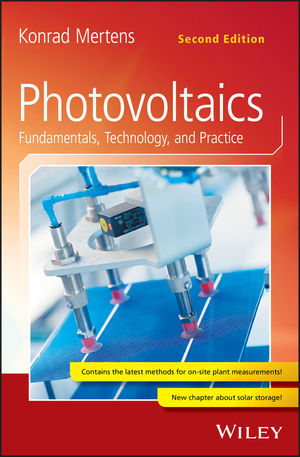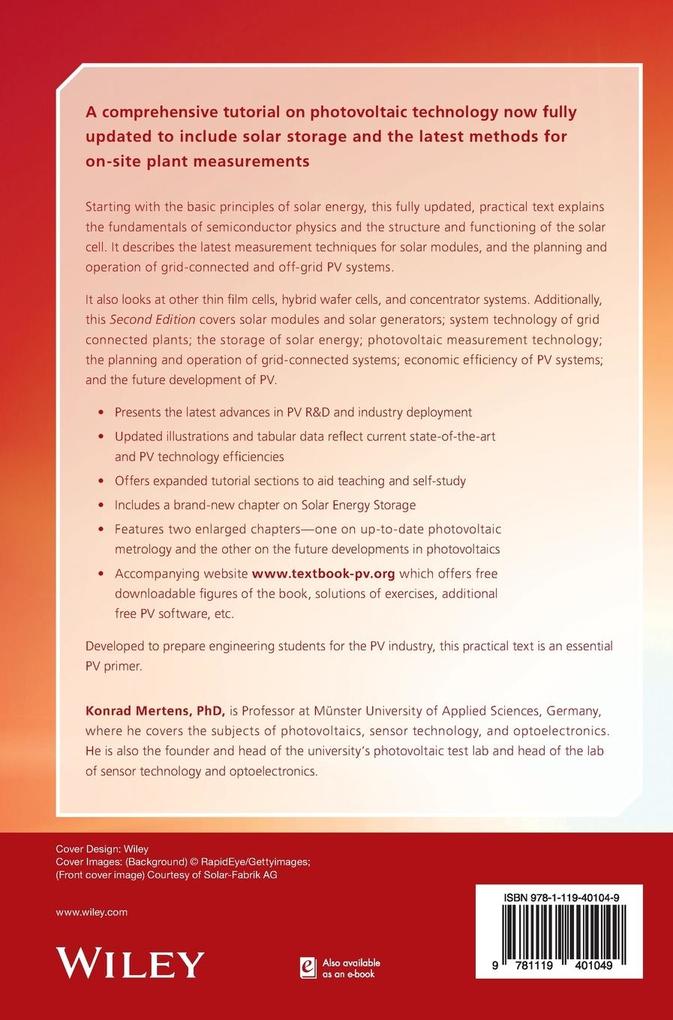A comprehensive tutorial on photovoltaic technology now fully updated to include solar storage and the latest methods for on-site plant measurements
Starting with the basic principles of solar energy, this fully updated, practical text explains the fundamentals of semiconductor physics and the structure and functioning of the solar cell. It describes the latest measurement techniques for solar modules, and the planning and operation of grid-connected and off-grid PV systems.
It also looks at other thin film cells, hybrid wafer cells, and concentrator systems. Additionally, this Second Edition covers solar modules and solar generators; system technology of grid connected plants; the storage of solar energy; photovoltaic measurement technology; the planning and operation of grid-connected systems; economic efficiency of PV systems; and the future development of PV.
* Presents the latest advances in PV R&D and industry deployment
* Updated illustrations and tabular data reflect current state-of-the-art and PV technology efficiencies
* Offers expanded tutorial sections to aid teaching and self-study
* Includes a brand-new chapter on Solar Energy Storage
* Features two enlarged chapters--one on up-to-date photovoltaic metrology and the other on the future developments in photovoltaics
* Comes along with the accompanying website www. textbook-pv. org which offers free downloadable figures of the book, solutions of exercises, additional free PV software etc.
Developed to prepare engineering students for the PV industry, this practical text is an essential PV primer.
Inhaltsverzeichnis
Preface to the First International Edition xv
Preface to the Second International Edition xvii
Abbreviations xix
1 Introduction 1
1.1 Introduction 1
1.1.1 Why Photovoltaics? 1
1.1.2 Who Should Read This Book? 2
1.1.3 Structure of the Book 2
1.2 What Is Energy? 3
1.2.1 De¿nition of Energy 3
1.2.2 Units of Energy 4
1.2.3 Primary, Secondary, and End Energy 5
1.2.4 Energy Content of Various Substances 6
1.3 Problems with Today's Energy Supply 7
1.3.1 Growing Energy Requirements 7
1.3.2 Tightening of Resources 8
1.3.3 Climate Change 9
1.3.4 Hazards and Disposal 11
1.4 Renewable Energies 11
1.4.1 The Family of Renewable Energies 11
1.4.2 Advantages and Disadvantages of Renewable Energies 12
1.4.3 Previous Development of Renewable Energies 13
1.5 Photovoltaics - The Most Important in Brief 13
1.5.1 What Does "Photovoltaics" Mean? 13
1.5.2 What Are Solar Cells and Solar Modules? 14
1.5.3 How Is a Typical Photovoltaic Plant Structured? 14
1.5.4 What Does a Photovoltaic Plant "Bring?" 15
1.6 History of Photovoltaics 16
1.6.1 How It all Began 16
1.6.2 The First Real Solar Cells 17
1.6.3 From Space to Earth 19
1.6.4 From Toy to Energy Source 20
2 Solar Radiation 23
2.1 Properties of Solar Radiation 23
2.1.1 Solar Constant 23
2.1.2 Spectrum of the Sun 23
2.1.3 Air Mass 25
2.2 Global Radiation 25
2.2.1 Origin of Global Radiation 25
2.2.2 Contributions of Di¿use and Direct Radiation 26
2.2.3 Global Radiation Maps 28
2.3 Calculation of the Position of the Sun 30
2.3.1 Declination of the Sun 30
2.3.2 Calculating the Path of the Sun 32
2.4 Radiation on Tilted Surfaces 35
2.4.1 Radiation Calculation with the Three-component Model 35
2.4.1.1 Direct Radiation 35
2.4.1.2 Di¿use Radiation 36
2.4.1.3 Re¿ected Radiation 37
2.4.2 Radiation Estimates with Diagrams and Tables 38
2.4.3 Yield Gain through Tracking 41
2.5 Radiation Availability and World Energy Consumption 41
2.5.1 The Solar Radiation Energy Cube 41
2.5.2 The Sahara Miracle 45
3 Fundamentals of Semiconductor Physics 47
3.1 Structure of a Semiconductor 47
3.1.1 Bohr's Atomic Model 47
3.1.2 Periodic Table of Elements 49
3.1.3 Structure of the Silicon Crystal 49
3.1.4 Compound Semiconductors 49
3.2 Band Model of a Semiconductor 51
3.2.1 Origin of Energy Bands 51
3.2.2 Di¿erences in Isolators, Semiconductors, and Conductors 53
3.2.3 Intrinsic Carrier Concentration 53
3.3 Charge Transport in Semiconductors 55
3.3.1 Field Currents 55
3.3.2 Di¿usion Currents 56
3.4 Doping of Semiconductors 57
3.4.1 n-Doping 57
3.4.2 p-Doping 58
3.5 The p-n Junction 59
3.5.1 Principle of Method of Operation 59
3.5.2 Band Diagram of the p-n Junction 61
3.5.3 Behavior with Applied Voltage 62
3.5.4 Diode Characteristics 63
3.6 Interaction of Light and Semiconductors 64
3.6.1 Phenomenon of Light Absorption 64
3.6.1.1 Absorption Coe¿cient 65
3.6.1.2 Direct and Indirect Semiconductors 65
3.6.2 Light Re¿ection on Surfaces 67
3.6.2.1 Re¿ection Factor 67
3.6.2.2 Antire¿ection Coating 69
4 Structure and Method of Operation of Solar Cells 71
4.1 Consideration of the Photodiode 71
4.1.1 Structure and Characteristics 71
4.1.2 Equivalent Circuit 73
4.2 Method of Function of the Solar Cell 73
4.2.1 Principle of the Structure 73
4.2.2 Recombination and Di¿usion Length 74
4.2.3 What Happens in the Individual Cell Regions? 75
4.2.3.1 Absorption in the Emitter 75
4.2.3.2 Absorption in the Space Charge Region 76
4.2.3.3 Absorption Within the Di¿usion Length of the Electrons 76
4.2.3.4 Absorption Outside the Di¿usion Length of the Electrons 76
4.2.4 Back-surface Field 77
4.3 Photocurrent 77
4.3.1 Absorption E¿ciency 78
4.3.2 Quantum E¿ciency 79
4.3.3 Spectral Sensitivity 79
4.4 Characteristic Curve and Characteristic Parameters 80
4.4.1 Short-circuit Current ISC 81
4.4.2 Open-circuit Voltage V OC 82
4.4.3 Maximum Power Point (MPP) 82
4.4.4 Fill Factor (FF) 82
4.4.5 E¿ciency ;; 83
4.4.6 Temperature Dependence of Solar Cells 83
4.5 Electrical Description of Real Solar Cells 85
4.5.1 Simpli¿ed Model 85
4.5.2 Standard Model (Single-diode Model) 86
4.5.3 Two-diode Model 86
4.5.4 Determining the Parameters of the Equivalent Circuit 88
4.6 Considering E¿ciency 90
4.6.1 Spectral E¿ciency 91
4.6.2 Theoretical E¿ciency 94
4.6.3 Losses in Real Solar Cells 96
4.6.3.1 Optical Losses, Re¿ection on the Surface 96
4.6.3.2 Electrical Losses and Ohmic Losses 98
4.7 High-e¿ciency Cells 99
4.7.1 Buried-contact Cell 99
4.7.2 Point-contact Cell (IBC Cell) 99
4.7.3 PERL and PERC Cell 101
5 Cell Technologies 103
5.1 Production of Crystalline Silicon Cells 103
5.1.1 From Sand to Silicon 103
5.1.1.1 Production of Polysilicon 103
5.1.1.2 Production of Monocrystalline Silicon 105
5.1.1.3 Production of Multicrystalline Silicon 106
5.1.2 From Silicon to Wafer 107
5.1.2.1 Wafer Production 107
5.1.2.2 Wafers from Ribbon Silicon 107
5.1.3 Production of Standard Solar Cells 108
5.1.4 Production of Solar Modules 111
5.2 Cells of Amorphous Silicon 112
5.2.1 Properties of Amorphous Silicon 112
5.2.2 Production Process 113
5.2.3 Structure of the Pin Cell 113
5.2.4 Staebler-Wronski E¿ect 115
5.2.5 Stacked Cells 116
5.2.6 Combined Cells of Micromorphous Material 118
5.2.7 Integrated Series Connection 119
5.3 Further Thin Film Cells 120
5.3.1 Cells of Cadmium-Telluride 120
5.3.2 CIS Cells 121
5.4 Hybrid Wafer Cells 123
5.4.1 Combination of c-Si and a-Si (HIT Cell) 123
5.4.2 Stacked Cells of III/V Semiconductors 124
5.5 Other Cell Concepts 125
5.6 Concentrator Systems 126
5.6.1 Principle of Radiation Bundling 126
5.6.2 What Is the Advantage of Concentration? 127
5.6.3 Examples of Concentrator Systems 128
5.6.4 Advantages and Disadvantages of Concentrator Systems 128
5.7 Ecological Questions on Cell and Module Production 129
5.7.1 Environmental E¿ects of Production and Operation 129
5.7.1.1 Example of Cadmium-Telluride 129
5.7.1.2 Example of Silicon 129
5.7.2 Availability of Materials 130
5.7.2.1 Silicon 130
5.7.2.2 Cadmium-Telluride 131
5.7.2.3 Cadmium Indium Selenide 131
5.7.2.4 III/V Semiconductors 132
5.7.3 Energy Amortization Time and Yield Factor 132
5.8 Summary 135
6 Solar Modules and Solar Generators 139
6.1 Properties of Solar Modules 139
6.1.1 Solar Cell Characteristic Curve in All Four Quadrants 139
6.1.2 Parallel Connection of Cells 139
6.1.3 Series Connection of Cells 141
6.1.4 Use of Bypass Diodes 142
6.1.4.1 Reducing Shading Losses 142
6.1.4.2 Prevention of Hotspots 144
6.1.5 Typical Characteristic Curves of Solar Modules 147
6.1.5.1 Variation of the Irradiance 147
6.1.5.2 Temperature Behavior 147
6.1.6 Special Case Thin-¿lm Modules 149
6.1.7 Examples of Data Sheet Information 150
6.2 Connecting Solar Modules 150
6.2.1 Parallel Connection of Strings 150
6.2.2 What Happens in Case of Cabling Errors? 152
6.2.3 Losses Due to Mismatching 153
6.2.4 Smart Installation in Case of Shading 153
6.3 Direct Current Components 156
6.3.1 Principle of Plant Construction 156
6.3.2 Direct Current Cabling 156
6.4 Types of Plants 158
6.4.1 Ground-mounted Plants 158
6.4.2 Flat-roof Plants 161
6.4.3 Pitched-roof Systems 162
6.4.4 Facade Systems 164
7 System Technology of Grid-connected Plants 165
7.1 Solar Generator and Load 165
7.1.1 Resistive Load 165
7.1.2 DC/DC Converter 166
7.1.2.1 Idea 166
7.1.2.2 Buck Converter 166
7.1.2.3 Boost Converter 169
7.1.3 MPP Tracker 171
7.2 Construction of Grid-connected Systems 172
7.2.1 Feed-in Variations 172
7.2.2 Plant Concepts 173
7.3 Construction of Inverters 174
7.3.1 Tasks of the Inverter 175
7.3.2 Line-commutated and Self-commutated Inverter 175
7.3.3 Inverters Without Transformers 175
7.3.4 Inverters with Mains Transformer 177
7.3.5 Inverters with HF Transformer 178
7.3.6 Three-phase Feed-in 179
7.3.7 Further Clever Concepts 180
7.4 E¿ciency of Inverters 181
7.4.1 Conversion E¿ciency 181
7.4.2 European E¿ciency 184
7.4.3 Clever MPP Tracking 185
7.5 Dimensioning of Inverters 186
7.5.1 Power Dimensioning 186
7.5.2 Voltage Dimensioning 187
7.5.3 Current Dimensioning 188
7.6 Requirements of the Grid Operators 188
7.6.1 Prevention of Stand-Alone Operation 188
7.6.2 Maximum Feed-in Power 190
7.6.3 Reactive Power Provision 191
7.7 Safety Aspects 194
7.7.1 Earthing of the Generator and Lightning Protection 194
7.7.2 Fire Protection 194
8 Storage of Solar Energy 197
8.1 Principle of Solar Storage 197
8.2 Batteries 198
8.2.1 Lead-acid Battery 199
8.2.1.1 Principle and Build-up 199
8.2.1.2 Types of Lead Batteries 201
8.2.1.3 Battery Capacity 203
8.2.1.4 Voltage Progression 203
8.2.1.5 Summary 204
8.2.2 Charge Controllers 204
8.2.2.1 Series Controller 204
8.2.2.2 Shunt Controller 205
8.2.2.3 MPP Controller 205
8.2.2.4 Examples of Products 206
8.2.3 Lithium Ion Battery 206
8.2.3.1 Principle and Build-up 207
8.2.3.2 Reactions During Charging and Discharging 208
8.2.3.3 Material Combinations and Cell Voltage 209
8.2.3.4 Safety Aspects 210
8.2.3.5 Charging Procedures 211
8.2.3.6 Battery Design 211
8.2.3.7 Lifespan 212
8.2.3.8 Application Areas 213
8.2.3.9 Summary 213
8.2.4 Sodium Sulfur Battery 213
8.2.4.1 Principle and Build-up 213
8.2.4.2 Peculiarities of the High Temperature Battery 214
8.2.4.3 Sodium Sulfur Batteries in Practice 215
8.2.4.4 Summary 216
8.2.5 Redox Flow Battery 216
8.2.5.1 Principle and Build-up 216
8.2.5.2 Behavior in Practice 218
8.2.5.3 Concrete Applications 219
8.2.5.4 Summary 220
8.2.6 Comparison of the Di¿erent Battery Types 220
8.3 Storage Use for Increase of Self-consumption 220
8.3.1 Self-consumption in Domestic Households 221
8.3.1.1 Solution Without Storage 222
8.3.1.2 Solution with Storage 223
8.3.1.3 Examples of Storage Systems 223
8.3.1.4 How Much Cost a Kilowatt-Hour? 225
8.3.1.5 The Smart Home 226
8.3.2 Self-consumption in Commercial Enterprises 227
8.3.2.1 Example Production Factory 227
8.3.2.2 Example Hospital 227
8.4 Storage Deployment from the Point of View of the Grid 228
8.4.1 Peak-shaving with Storages 229
8.4.2 Governmental Funding Program for Solar Storages 229
8.5 Stand-alone Systems 232
8.5.1 Principal Structure 232
8.5.2 Examples of Stand-alone Systems 232
8.5.2.1 Solar Home Systems 232
8.5.2.2 Hybrid Systems 234
8.5.3 Dimensioning Stand-alone Plants 235
8.5.3.1 Acquiring the Energy Consumption 235
8.5.3.2 Dimensioning the PV Generator 236
8.5.3.3 Selecting the Battery 238
9 Photovoltaic Metrology 241
9.1 Measurement of Solar Radiation 241
9.1.1 Global Radiation Sensors 241
9.1.1.1 Pyranometer 241
9.1.1.2 Radiation Sensors from Solar Cells 243
9.1.2 Measuring Direct and Di¿use Radiation 244
9.2 Measuring the Power of Solar Modules 245
9.2.1 Build-up of a Solar Module Power Test Rig 245
9.2.2 Quality Classi¿cation of Module Flashers 246
9.2.3 Determination of the Module Parameters 247
9.3 Peak Power Measurement at Site 248
9.3.1 Principle of Peak Power Measurement 248
9.3.2 Possibilities and Limits of the Measurement Principle 248
9.4 Thermographic Measuring Technology 249
9.4.1 Principle of Infrared Temperature Measurement 250
9.4.2 Bright Thermography of Solar Modules 251
9.4.3 Dark Thermography 254
9.5 Electroluminescence Measuring Technology 254
9.5.1 Principle of Measurement 254
9.5.2 Examples of Photos 255
9.5.3 Low-cost Outdoor Electroluminescence Measurements 257
9.6 Analysis of Potential Induced Degradation (PID) 259
9.6.1 Explanation of the PID E¿ect 260
9.6.2 Test of Modules for PID 262
9.6.3 EL Investigations to PID 263
10 Design and Operation of Grid-connected Plants 265
10.1 Planning and Dimensioning 265
10.1.1 Selection of Site 265
10.1.2 Shading 265
10.1.2.1 Shading Analysis 266
10.1.2.2 Near Shading 266
10.1.2.3 Self-shading 268
10.1.2.4 Optimized String Connection 269
10.1.3 Plant Dimensioning and Simulation Programs 270
10.1.3.1 Inverter Design Tools 270
10.1.3.2 Simulation Programs for Photovoltaic Plants 270
10.2 Economics of Photovoltaic Plants 272
10.2.1 The Renewable Energy Law 273
10.2.2 Return Calculation 273
10.2.2.1 Input Parameters 273
10.2.2.2 Amortization Time 274
10.2.2.3 Property Return 274
10.2.2.4 Pro¿t Increase Through Self-consumption of Solar Power 276
10.2.2.5 Further In¿uences 276
10.3 Surveillance, Monitoring, and Visualization 277
10.3.1 Methods of Plant Surveillance 277
10.3.2 Monitoring PV Plants 278
10.3.2.1 Speci¿c Yields 278
10.3.2.2 Losses 279
10.3.2.3 Performance Ratio 279
10.3.2.4 Concrete Measures for Monitoring 280
10.3.3 Visualization 280
10.4 Operating Results of Actual Installations 281
10.4.1 Pitched Roof Installation from 1996 281
10.4.2 Pitched Roof Installation from 2002 282
10.4.3 Flat Roof from 2008 283
11 Future Development 285
11.1 Potential of Photovoltaics 285
11.1.1 Theoretical Potential 285
11.1.2 Technically Useful Radiation Energy 285
11.1.2.1 Roofs 286
11.1.2.2 Facades 286
11.1.2.3 Träc Routes 287
11.1.2.4 Free Areas 287
11.1.3 Technical Electrical Energy Generation Potential 287
11.1.4 Photovoltaics versus Biomass 288
11.2 E¿cient Promotion Instruments 289
11.3 Price and Feed-in Tari¿ Development 290
11.3.1 Price Development of Solar Modules 290
11.3.2 Development of Feed-in Tari¿s 292
11.4 Renewable Energies in Today's Power Supply System 292
11.4.1 Structure of Electricity Generation 293
11.4.2 Types of Power Plants and Control Energy 293
11.4.3 Interplay Between Sun and Wind 294
11.4.4 Exemplary Electricity Generation Courses 295
11.5 Thoughts on Future Energy Supply 298
11.5.1 Consideration of Di¿erent Future Scenarios 298
11.5.2 Options to Store Electrical Energy 301
11.5.2.1 Pumped Storage Power Plants 301
11.5.2.2 Compressed Air Storage 301
11.5.2.3 Battery Storage 302
11.5.2.4 Electric Mobility 302
11.5.2.5 Hydrogen as Storage 302
11.5.2.6 Power to Gas: Methanation 303
11.5.3 Alternatives to Storage 304
11.5.3.1 Active Load Management by Smart Grids 304
11.5.3.2 Expansion of the Electricity Grids 304
11.5.3.3 Limitation of the Feed-in Power 304
11.5.3.4 Use of Flexible Power Plants 304
11.6 Conclusion 305
12 Exercises 307
A Solar Radiation Diagrams 317
B Checklist for Planning, Installing, and Operating a Photovoltaic Plant 327
C Physical Constants/Material Parameters 329
References 331
Further Information on Photovoltaics 339
Index 341














